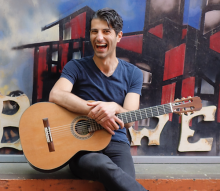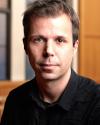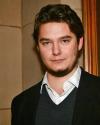The latest installment of an ongoing series created by artistic director Naeim Rahmani ('10 BM, Guitar Performance), the program includes commissioned works by Iranian composers living outside of Iran and Seattle-based composers with strong ties to the UW Composition Program: Huck Hodge, Joël-François Durand, Jeff Bowen, and Yigit Kölat.
Farzia Fallah
Thirty-Three Drops of Water (2020)
In this piece I work with individual sounds, some of them very dry, some of them microtonal and some very fragile. I shape them to drops of sounds. Each and every sound is celebrated, as each drop means a piece of life. Water is life.
Yiǧit Kolat
The Oasis of Now (2020)This piece can be considered in two distinct ways:
- A meditation on the following lines from Sohrab Sepehri’s poem " The Oasis of Now":
“If you are coming to me
approach gently, softly, lest you crack
the fragile china of my solitude.”
- A meditation on this “situation”:
“The musicians have departed to build new lives, leaving their instruments behind. The doctors have done the same, as have the teachers, engineers, artists... After drying up all the life-giving flows in this land, what remains to us are the distant echoes of their streams.”
Aida Shirazi
Carrying the Song of Life (2020)Carrying the Song of Life is based on the poem I am a Leaf by Yone Noguchi. My work
explores the subtle, yet profound imagery of Noguchi’s poetry, influenced by Japanese haiku. Noguchi uses images from Nature to reflect on the delicate and ephemeral quality of life and existence.Carrying the Song of Life tries to create an intimate, contemplative space that blends the voice and synthesizer. The drone with a granular texture provides a bed for the voice to move in an improvisatory manner and bring forth the depth of the words.
Jeffrey Bowen
Weir (2020)
“There are rumors that the Bridge of 33 Arches will collapse if it stays dry much longer. They
used a material that must not dry out.”
-Resident of Isfahan, in conversation with Thomas Erdbrink
Whether or not the collapse of this iconic bridge is imminent, this image—of a structure whose integrity is dependent on the river that courses through its arches—resonated strongly for me, as it points to the inescapable dependence of human activity and ingenuity on the presence and movement of essential natural sources. This piece begins with (and is built upon) processed sounds periodically emanating from the piano, which are treated as such a source, and consist of recordings of the Tolt and Cedar rivers colored by fragments extracted from Naeim Rahmani’s recitation of Sohrab Sepheri’s poem, The Fishes’ Message.
The harmonics played inside the piano introduce pitches quite close to specific frequencies of this sound source, creating acoustic beating patterns that provide the rhythmic basis of the sections that follow. The rest of the piece explores the possibility of building and extending musical structures from this interaction with a source outside the ensemble, as well as how this musical activity adapts in the source’s absence.
Joël-François Durand
In a weightless quiet, for solo violin (2020)In a weightless quiet belongs to a group of works that I started to write in 2019, in which I explore the formal and structural potentials of an acoustic phenomenon known to all musicians when they tune their instruments: the beats that occur when two tones of very close frequencies are played at the same time. The first work in this group is for viola and ensemble (Geister, schwebende Geister, for viola and ensemble 2019-20); the second is this violin piece and the third to date is my second string quartet Canto de amigo written in 2020. In each of these works, the beats are generated by playing one of the open strings of the instruments at the same time as a similar pitch with a microtonal deviation, on another string.
What I find fascinating in this use of controlled beat patterns is that they actually permit to directly experience what is usually considered a physical/mathematical concept. In sensory experience (auditory perception), we cannot be aware of the mathematical ratio between the frequencies of two notes played at the same time; it's an abstract concept (we don't hear a 3:2 ratio when we hear a fifth; we hear a fifth). But when the pitches are very close, the phenomenon of "first-order beat" becomes an actual experience. How this works is fairly simple to explain: if for example, the two frequencies are 3 Hz apart—say, 443 Hz and 440 Hz—we hear two things: first, the two original frequencies become one single tone (mathematically, it’s the median value of the two); additionally, we hear a pulsation of three beats animating this single tone. The “median value” in this case is 441.5 Hz; and the pulsation that accompanies it—the difference between the two original frequencies—is three beats per second which, when we hear them, is the audible manifestation of an arithmetic equation, in this case, the subtraction 443 - 440 = 3!
The form of In a weightless quiet is based on a series of sections that explore the tonal regions of the three open strings of the violin A, D and E, and their extensions through microtones that generate 3, 5, 7 and 11 beats per second. After an introduction centered on A, the sections that follow tend to begin with the low D and ascend from to A and E in several successive waves. The focus on these three tonal regions and their interactions with each other give each section a particular color and character. The phenomenon of beats itself can be presented in gestures that are sometimes too fast for the pulsations to be clearly audible (as in the very beginning for example). At other times, longer held notes make them clearer and the beatings are then clearly perceived as regular rhythmic subdivisions of the basic pulse. So, when they are not clearly heard, one cannot be sure whether it's because the pitches are “out of tune” or whether they express something else. When the line slows down, the beats are revealed without ambiguity. In between these two extremes, there is a whole vocabulary of gestures that can evoke these subdivisions in different ways: repeated notes, slow or rapid alternance between two strings, tremolos etc. I find it fascinating how these beats have a sort of extra-worldly character, appearing seemingly out of nowhere since they are not directly produced by the performer, who is playing two pitches but not the rhythmic beating itself.
—Joël-François Durand
Huck Hodge
The Simple and Unvarying Geometry of Breaths (2020)Life is a lovely ritual.
Life has wings as vast as death,
It is a leap the size of love.
Life is not something to be forgotten on the windowsill of habit,
Life is the rapture of a hand that reaps.
Life is the first black fig in the acrid mouth of summer.
Life is the dimensions of a tree from the eyes of an insect.
Life is the experience that a bat has in the dark.
Life is the homesickness that a migrating bird feels.
Life is the whistle of a train that turns through the dream of a bridge.
Life is observing a garden from the obstructed windows of an airplane.
It is the news of the launch of a rocket into space,
Touching the loneliness of the Moon,
The notion of smelling a flower on another planet.
Life is the washing of a plate.
Life is the square root of a mirror.
Life is a blossom to the power of eternity.
Life is the Earth multiplied by our heartbeats.
Life is the simple and unvarying geometry of breaths.
Adapted from Sohrab Sepehri, & Karim Emami (trans.).
(1982). Water's Footsteps: A Poem. Iranian Studies, 15(1/4), 97-116.
In the last decade, Iran has experienced severe drought tied to climate change. In Isfahan this has been most noticeable in the parched riverbed of the Zayandehroud river. The once flowing river cut across the landscape and carved timeless memories in people’s minds. The “Empty River of Life” ran under the historic bridges and for more than 400 years, the Se-o-se pol (Bridge of 33 Arches) made its motion and power visible. While the bridge is standing, the river is no longer running as it used to. One day it’s flowing and the next day it is literally gone. The future of the river, like the future of the country, is uncertain. This project is intended to both pay homage to the river and to raise people’s awareness about the drought and its impacts.
Biographies
Award winning guitarist Naeim Rahmani was born in Isfahan, Iran and immigrated to the United States as a refugee in 2003. Presently based in Seattle, Naeim completed his Master's degree with Rene Izquierdo at the University of Wisconsin at Milwaukee.
Naeim has performed throughout the US and internationally. He enjoys bringing his music to small community or arthouse spaces where he can interact with the audience. His performance venues have included everything from private homes and community churches, to a renovated industrial space in Oaxaca, Mexico, ancient churches along the Camino Santiago in Spain, and arthouses in Berlin. In all of these places Naeim brings his deeply personal style to create an intimate musical experience for the audience.




